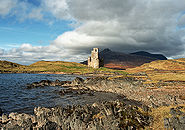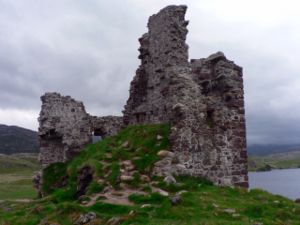
Ardvreck Castle
Encyclopedia

Loch Assynt
Loch Assynt is a freshwater loch in Sutherland, Scotland, 8 km ENE of Lochinver.Situated in a spectacular setting between the heights of Canisp, Quinag and Beinn Uidhe, it receives the outflow from Lochs Awe, Maol a' Choire, and Leitir Easaich. It discharges into the sea at Loch Inver, via the...
in Sutherland
Sutherland
Sutherland is a registration county, lieutenancy area and historic administrative county of Scotland. It is now within the Highland local government area. In Gaelic the area is referred to according to its traditional areas: Dùthaich 'IcAoidh , Asainte , and Cataibh...
, north west Highland
Highland (council area)
Highland is a council area in the Scottish Highlands and is the largest local government area in both Scotland and the United Kingdom as a whole. It shares borders with the council areas of Moray, Aberdeenshire, Perth and Kinross, and Argyll and Bute. Their councils, and those of Angus and...
, Scotland
Scotland
Scotland is a country that is part of the United Kingdom. Occupying the northern third of the island of Great Britain, it shares a border with England to the south and is bounded by the North Sea to the east, the Atlantic Ocean to the north and west, and the North Channel and Irish Sea to the...
, Ardvreck Castle is a ruined castle dating from the 16th century. The ruins can be reached by driving along the A837 which follows the north shore of Loch Assynt from the village of Inchnadamph
Inchnadamph
Inchnadamph is a hamlet in Assynt, Sutherland, Scotland. The name is an anglicisation of the Gaelic name Innis nan Damh meaning 'meadow of the stags'...
. Care should be taken when walking around the site as falling masonry is a possible danger.
History of Ardvreck
The castle is thought to have been constructed around 1590 by the Clan MacLeodClan MacLeod
Clan MacLeod is a Highland Scottish clan associated with the Isle of Skye. There are two main branches of the clan: the Macleods of Harris and Dunvegan, whose chief is Macleod of Macleod, are known in Gaelic as Sìol Tormoid ; the Macleods of Lewis, whose chief is Macleod of The Lewes, are known in...
family who owned Assynt
Assynt
Assynt is a civil parish in west Sutherland, Highland, Scotland – north of Ullapool.It is famous for its landscape and its remarkable mountains...
and the surrounding area from the 13th century onwards. Indeed Sutherland, the area in which Ardvreck is situated, has long been a stronghold of the clan MacLeod. The most well known historical tale concerning the castle is that on April 30th 1650 James Graham, the Marquis of Montrose, was captured and held at the castle before being transported to Edinburgh
Edinburgh
Edinburgh is the capital city of Scotland, the second largest city in Scotland, and the eighth most populous in the United Kingdom. The City of Edinburgh Council governs one of Scotland's 32 local government council areas. The council area includes urban Edinburgh and a rural area...
for trial and execution. Montrose was a Royalist
Cavalier
Cavalier was the name used by Parliamentarians for a Royalist supporter of King Charles I and son Charles II during the English Civil War, the Interregnum, and the Restoration...
, fighting on the side of Charles I
Charles I of England
Charles I was King of England, King of Scotland, and King of Ireland from 27 March 1625 until his execution in 1649. Charles engaged in a struggle for power with the Parliament of England, attempting to obtain royal revenue whilst Parliament sought to curb his Royal prerogative which Charles...
against the Covenanters. Defeated at the Battle of Carbisdale
Battle of Carbisdale
The Battle of Carbisdale took place close to the Village of Culrain on 27 April 1650 and was part of the Wars of the Three Kingdoms...
, he sought sanctuary at Ardvreck with Neil MacLeod of Assynt. At the time, Neil was absent and it is said that his wife, Christine, tricked Montrose into the castle dungeon and sent for troops of the Covenanter Government. Montrose was taken to Edinburgh, where he was executed on 21 May 1650, using the traditional method for traitors: hanging, drawing and quartering.
Ardvreck Castle was attacked and captured by the Clan MacKenzie
Clan MacKenzie
Clan Mackenzie is a Highland Scottish clan, traditionally associated with Kintail and lands in Ross-shire.-Origins:The Mackenzies, a powerful clan of Celtic stock, were not among the clans that originated from Norman ancestry. Descendants of the long defunct royal Cenél Loairn of Dál Riata, they...
in 1672, who took control of the Assynt lands. In 1726 they constructed a more modern manor house nearby, Calda House, which takes its name from the Calda burn beside which it stands. The house burned down under mysterious circumstances one night in 1737 (see below) and both Calda House and Ardvreck Castle stand as ruins today.http://www.lochinver.bordernet.co.uk/places/ardvreck.html
Architecture

Ghosts and legends of Ardvreck
The castle is said to be haunted by two ghosts, one a tall man dressed in grey who is supposed to be related to the betrayal of Montrose and may even be Montrose himself. The second ghost is that of a young girl. The story tells that the MacLeods procured the help of the DevilDevil
The Devil is believed in many religions and cultures to be a powerful, supernatural entity that is the personification of evil and the enemy of God and humankind. The nature of the role varies greatly...
to build the castle and in return the daughter of one of the MacLeod chieftains was betrothed to him as payment. In despair of her situation, the girl threw herself from one of the towers and was killed.
The nearby ruins of Calda house are also supposed to be haunted. The legend says that the Mackenzie family organised a family gathering there one Saturday and that the celebrations continued past midnight into the Sabbath day. At some point a fire broke out, possibly caused by a lightning strike, and all the inhabitants perished as the house burned to the ground. The causes of the fire are uncertain, but inhabitants of the Assynt area state that it was a manifestation of divine wrath as the family had been merry-making on the Lord's Sabbath day. Indeed, stories are told that there was a survivor of the fire, a piper who was spared the flames because he refused to play the pipes past the midnight hour.
A number of ghost sightings have been recorded around the area of the Calda ruins, including that of a ghostly woman who haunts the site itself. Strange lights have also been seen there at night, and several people have claimed that they have seen car headlights approach them on the road there at night, but after waiting for the vehicle to pass, no car has appeared.

